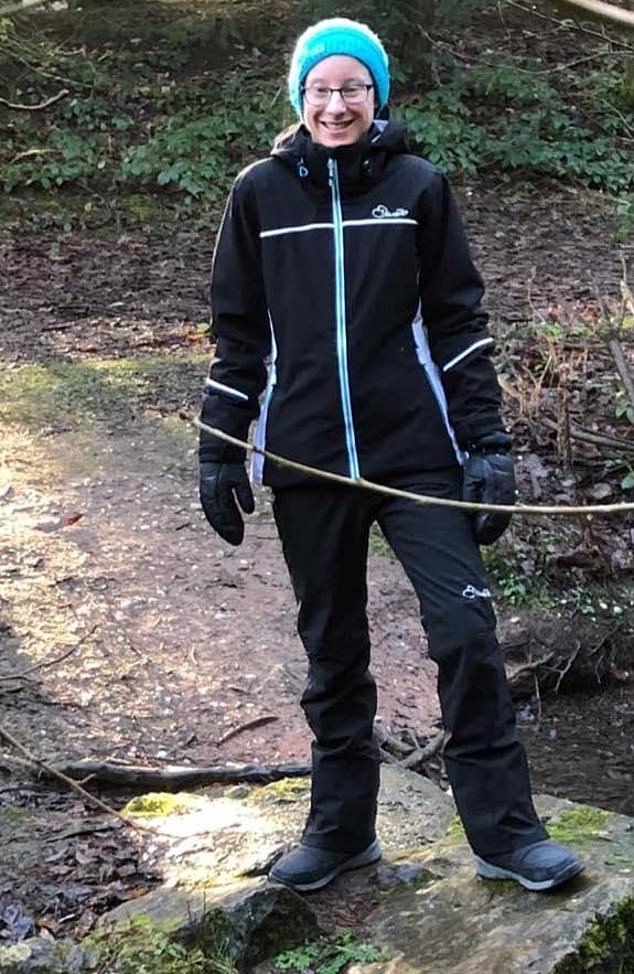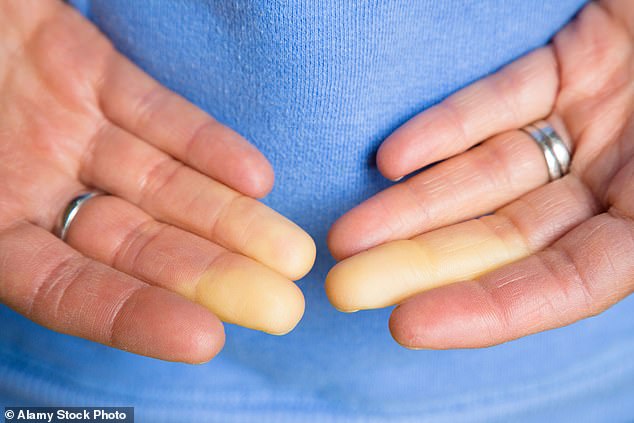During this heatwave, while most of us welcome the blast of cool air in an air-conditioned shop or restaurant, Karen Raney-Marr dreads it.
She has to carry gloves and a hoodie with her at all times – even in 30C heat – just in case she ends up somewhere that’s air conditioned. She even has to drive using a heated steering wheel.
For Karen, 37, a healthcare play specialist from St Albans in Hertfordshire, suffers from Raynaud’s syndrome. It is a condition that affects around ten million Britons, where even a slight change in temperature causes a person’s extremities to become cold and numb, changing colour from white to blue then red – with sometimes excruciating pins and needles as the blood flow is restored.
While it usually affects the fingers and toes, some people also experience it in their lips, nose, ears and even nipples.
The attacks are often painful and can be debilitating, making it difficult to perform even simple tasks such as doing up buttons.
Raynaud’s is caused by spasms in the tiny blood vessels, which makes them constrict. The cause is not clear, although it’s four times more common in women, and there may be a genetic link as it can run in families. It typically appears before the age of 30.
Around three in ten of those affected experience symptoms all year round, with experts warning that the warming climate ironically means sufferers like Karen are also experiencing symptoms in the hottest weather.
‘Air conditioning in offices and shops can be a major issue for many people who knowingly, or unknowingly, have Raynaud’s,’ explains Sue Farrington, chief executive of Scleroderma & Raynaud’s UK.
‘And the concern is that with a warmer climate this challenge isn’t going to go away and is likely to cause increased discomfort.’

Karen Raney-Marr has to wrap up even in warm weather to avoid the painful symptoms

Raynaud’s syndrome causes a person’s extremities to become cold and numb, changing colour from white to blue then red
Karen was diagnosed with the condition when she was 18 after years of suffering from painful chilblains.
‘The doctor told me there was no cure and it was just one of those things I had to put up with,’ she recalls.
Not surprisingly, winters were hard – as well as chilblains, her fingers would swell from coming into a warm house from the cold outside.
When she was 21 the pain was so bad that Karen was hospitalised and given infusions of hormone-like drugs that enlarge the blood vessels to improve circulation.
But as summers in the UK have become hotter, and more and more public areas have air-conditioning, Karen has noticed her condition often worsens in summer, too.
‘In winter I can plan for it – I know I’ll need gloves and warm clothes – but in 30-degree heat it’s harder,’ she says.
‘I can wear shorts and a T-shirt outside but if I go indoors, such as in a shopping centre and there’s air conditioning, I will need my gloves and hoodie. People often stare and wonder why on earth I am dressed like this when they are in vests and shorts.’
Karen tries to avoid places such as shopping centres and gyms, which tend to be air conditioned, but can be caught out. She says: ‘Recently I went to the theatre and there was air conditioning. I’d dressed nicely for a night out and wasn’t prepared – I only had a small thin pair of gloves with me.
‘I put them on, but the air conditioning was so strong that I got painful chilblains and swelling within minutes. It ruined the whole night for me. I managed to see the whole show, but it was agony.’
Karen also can’t have air conditioning on in her car – meaning any passengers have to swelter.
‘I do put it on a bit for people if they feel too hot, but only as much as I can stand – then have to turn it off,’ she says. ‘I also have to have a heated steering wheel.’
On holiday, Karen can’t even enjoy a dip in the pool because it involves going from hot weather to the cool water.

Karen tries to avoid places such as shopping centres and gyms, which tend to be air-conditioned – and usually has a pair of gloves with her
‘I can’t risk swimming, so instead I float on top on a Lilo,’ she says.
‘Despite being as common as hay fever, Raynaud’s is relatively unknown and can affect people’s ability to do everyday tasks,’ says Sue Farrington. ‘And as many as three million experience attacks all year round.’
For while Raynaud’s is associated with cold weather, ‘what can trigger an attack is actually a change in temperature, so going from warm to cold’, explains Gemma Cornwell, head of fundraising and engagement at Scleroderma & Raynaud’s UK.
‘More people are coming forward to us as they struggle in an office, or shops and other air-conditioned areas.
‘At work it can restrict the movement in their fingers and means they can’t even type on a keyboard. And yet you have everyone else in the office warm and wanting the air con really low.’
The charity encourages those affected to let their co-workers know they have Raynaud’s as many people will not have heard of it.
‘If you work in an office under a fan or air conditioning unit – ask to be moved away,’ suggests Gemma Cornwell.
Other steps to consider include having a portable heater and heated mouse and light/soft touch keyboard.
‘We suggest thinking about having a pair of gloves – even if that looks a bit strange in hot weather,’ she adds. (It’s not necessary to wear the gloves all day but just when entering somewhere with a cooler temperature.)
One theory is that the blood vessels in the extremities constrict in order to prevent heat loss from key areas in the core such as the heart – so keeping the entire body warm (not just the extremities) is crucial.
‘We recommend wearing thin layers – as having a layer of clothing close to your core helps,’ says Ms Cornwell.
‘It’s also less obvious [than thick gloves] if you have another layer under a T-shirt. And there are also heated hand and foot warmers you can get – including those you can put in your pockets if you want to be more discreet.’
Attacks can also be triggered by stress, she explains. ‘Even worrying about an attack can cause an attack, so try to manage stress levels.’
Karen now has preventative treatment in the form of regular infusions of medication every three months.
The drugs (iloprost or epoprostenol) dilate the blood vessels, improving circulation. They belong to a group called prostaglandins, hormone-like substances that are found naturally in the body, and their effect lasts for weeks.
‘I have this for six hours a day in hospital, five days in a row every three months,’ says Karen. ‘It’s exhausting but the only way I can then function for the next few weeks.’
She also continues to consciously avoid air conditioning as much as she can.
‘I love warm weather and it should be a time I get a break from my condition,’ she says. ‘But instead the air conditioning that gives everyone else comfort makes my life hell.’
If you suspect you might have Raynaud’s, take this 60-second test: sruk.co.uk/about-raynauds/diagnosing-raynauds/take-our-online-raynauds-test
For further information, visit: sruk.co.uk












